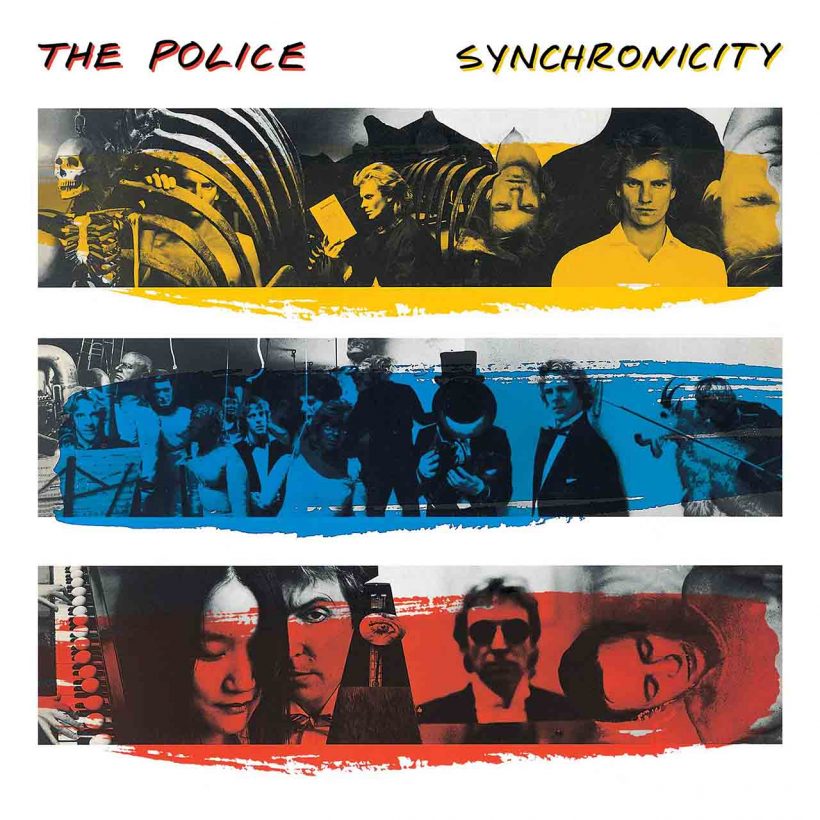Uncovering The Influences On The Police’s ‘Synchronicity’
The group’s 1983 triumph was packed with huge hits that go down easy and bear big ideas.

On The Police’s stunning swan song, Synchronicity, the band raised the bar before leaving the building. Mixing funk, jazz, electronics, international flavors, and more, it’s simultaneously their most musically sophisticated and most immediately accessible album, packed with huge hits that go down easy and bear big ideas. It’s undoubtedly the only 80s pop blockbuster whose inspirations include a 1950s philosophical treatise, a series of classical violin pieces, and an apocalyptic 1919 poem. If the works that helped shape the trio’s 1983 triumph seem somewhat on the heady side, remember that The Police were a more intellectual lot than your average rockers. In celebration of the Synchronicity deluxe set containing dozens of rarities, let’s look at a handful of the album’s influences.
Order the 40th anniversary edition of The Police’s Synchronicity now.
Carl Jung – Synchronicity: An Acausal Connecting Principle
Opening track “Synchronicity 1” is directly indebted to the writings of Swiss psychology pioneer Carl Jung. As early as the 1930s, Jung speculated about the paranormal connections between seemingly unrelated incidents. He dubbed his concept “synchronicity,” and first included his monograph Synchronicity: An Acausal Connecting Principle as part of a larger publication in 1952 before releasing it on its own. Jung didn’t live long enough to hear The Police’s infectious musical summary of his ideas, but it’s still satisfying to imagine him bopping around his office as Sting wails about “the connecting principle.” Sting excitedly told Timothy White in a Penthouse interview, “for a songwriter, that idea of Jung’s that two events can be linked not causally or logically but symbolically is very important – that’s what artists have been doing for years! They use symbols to maximum effect!”
Homer – The Odyssey
Hands up if the first place you heard about Scylla and Charybdis was “Wrapped Around Your Finger.” Your English teacher might have preferred you’d encountered them in The Odyssey first, but it’s tough to compete with the reach of a smash hit song. In Homer’s epic saga, which dates back to around the eighth century B.C., Odysseus’s ship sails through a treacherous channel with frightful six-headed beast Scylla on one side and deadly whirlpool Charybdis on the other. Before starting The Police, Sting taught English for a couple of years, so the classics were surely still ingrained in his brain.
Captain Beefheart
The Andy Summers-penned “Mother,” a cracked, careening trip into the deep end of an Oedipus complex, was fortunately not inspired by personal experience. Summers told radio station WBAB that he “was dead scared that my mother, my own mother, would be incredibly offended. She laughed her ass off; she thought it was great.” Between the deliciously deranged singing (the guitarist takes a rare lead vocal turn) and the mad carnival atmosphere, you barely even notice the tune is in 7/4 time. In the liner notes to the Synchronicity box, Summers reveals, “At that point in time, I was listening to a lot of Captain Beefheart… I was really into that very gnarly, totally off-the-wall music.” It’s not a huge stretch to imagine Beefheart’s feral howl inhabiting the thorny musical thicket Summers and company summon here.
W.B. Yeats – “The Second Coming”
Yeats’s legendary 1919 poem “The Second Coming,” written in the spiritual hangover following World War I, famously described a world in which “the centre cannot hold,” where everything’s coming apart at the seams. The piece is reportedly the source of Sting’s reference to “spiritus mundi” (the spirit of the world) in “Synchronicity 1.” But the gradually unravelling landscape the poem depicts also has plenty in common with the foreboding perspective of “Synchronicity 2.”
Strontium 90 – “3 O’Clock Shot”
If you have a rich enough history, sometimes pieces of your own past can pop back into your mind and offer new possibilities. In 1977, Sting and Stewart Copeland played with Andy Summers for the first time in Mike Howlett’s short-lived Strontium 90, a New Wave detour for the former Gong bassist. They split without releasing a record, but a 1997 collection of live tracks and demos delivered a revelation. When Sting was putting together Synchronicity’s funky existential plaint “O My God,” he reached all the way back to Strontium 90’s “3 O’Clock Shot” to give the latter’s first verse a brand new home. Perhaps feeling a little cheeky about pilfering from himself, he then doubled down by quoting part of “Every Little Thing” for the final verse.
Bela Bartok – 44 Duos for Two Violins
In 1931, Hungarian composer Bela Bartok wrote a string of 44 very short violin duets basically designed as student exercises, with the difficulty level and harmonic complexity increasing throughout the series. The ever-ambitious Andy Summers learned them, covering both parts himself. He wanted to cut an album of them as a duo with his buddy Robert Fripp of King Crimson, but it never happened. However, when Fripp and Summers recorded 1982’s I Advance Masked together, Summers couldn’t help but bring his Bartok influence to bear. Soon after, at the Synchronicity sessions, Summers was called upon to kick “Every Breath You Take” to the next level with a definitive guitar part. “I was working on one of those little riffs that [Fripp and I] had done,” he told Vic Garbarini on WHFS, “which was sort of Bartok, ‘Painting and Dance’ it was called.” Channeling that piece’s Bartok vibe into something a little more radio-friendly, Summers cemented the Police tune’s place in history.
Paul Bowles – The Sheltering Sky
Fripp figures into another Synchronicity back story too. The Police’s “Tea in the Sahara” was the second ‘80s rock tune inspired by Paul Bowles’ 1949 novel The Sheltering Sky. The first was the languid instrumental track of the same name from King Crimson’s 1981 album Discipline. The Fripp/Summers connection coming into play again, Summers flipped a copy of the novel to Sting, who was inspired enough to concoct a dreamy narrative based on Part One of the book, a section titled – you guessed it – Tea in the Sahara. Over a shimmering, impressionistic backdrop, the song adapts Bowles’ story-within-a-story of three sisters who wait seemingly forever to be joined by a prince for tea in the desert.
Order the 40th anniversary edition of The Police’s Synchronicity now.














